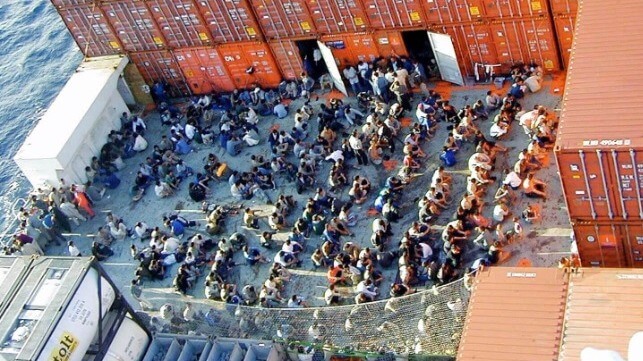Courage Under Pressure: Capt. Arne Rinnan and the "Tampa Affair"

Captain Arne Rinnan will be remembered as a seafarer of incredible personal courage and professionalism. He upheld his honour, stood behind his decisions, and ultimately withstood an international diplomatic crisis.
On 24 August 2001, Captain Rinnan was the Master of the Norwegian-flagged freighter MV Tampa, sailing in the Indian Ocean from Australia to Europe. Australian search and rescue authorities requested Tampa to respond to the fishing boat ‘Palapa’ in distress with 438 refugees onboard. Palapa was stranded in international waters between Indonesia and Christmas Island (an Australian territory in the Indian Ocean, approximately 1,000 nautical miles Northwest of Australia).
Captain Rinnan said: "When we arrived, it was obvious to us that it was coming apart. Several of the refugees were obviously in a bad state and collapsed when they came on deck to us. 10 to 12 of them were unconscious, several had dysentery and a pregnant woman suffered abdominal pains."
Captain Rinnan made the decision to embark the refugees aboard Tampa. This was not only a basic humanitarian decision, but the obligation of any master at sea upon encountering souls in distress. However, this left Captain Rinnan now with 465 people onboard his ship, which was designed for only 30 crew. Per international seafaring custom, survivors are to be taken to the closest suitable port for medical treatment. Tampa set a course for the Indonesian city of Merak, the closest deepwater port with facilities able to accommodate her.
However, when some refugees noticed the ship was turning north towards Indonesia (not south towards Australia) tensions onboard escalated. Some of the refugees threatened to commit suicide onboard, and others entered the ship’s bridge and demanded passage to Australia. For what started as a routine voyage, the rapidly escalating situation would have been totally unpredictable just days beforehand.
Captain Rinnan spent two days requesting assistance from Australian authorities to land the refugees at Christmas Island. Despite his pleas, the Australian Government refused permission for Tampa to enter Australia's territorial waters and threatened to prosecute Captain Rinnan as a people smuggler if Tampa approached.
Tampa did not have sufficient food or medical supplies for so many people. In this condition, Tampa was now unseaworthy and unable to proceed further. Captain Rinnan's repeated requests to dock at Christmas Island were denied, despite a serious distress situation developing at sea. Increasingly concerned for the safety of the asylum seekers and the crew, Captain Rinnan declared an emergency and proceeded into Australian waters without permission.
On the same day, the Australian Government rushed to pass the 'Border Protection Bill' in Parliament. The bill would grant the Australian Government the power to remove any foreign ship in Australian waters. It was backdated to give authority for the boarding of the Tampa, and ensured that no Australian court could review the actions of an Australian military officer.
Prime Minister John Howard said, “I believe it is in Australia’s national interest that we draw a line on what is increasingly becoming an uncontrollable number of illegal arrivals in this country.”
The Australian Government sent the SAS (an elite military unit) to board the ship and seize control. As any master will attest, this is a shocking development for a civilian cargo ship. Such boardings tread a fine line between sovereignty and piracy.
The Australian SAS instructed Captain Rinnan to retreat to international waters. He refused, as the ship was unsafe to sail until the refugees had been offloaded. The tense dispute was escalating into a diplomatic crisis. Norway reported Australia to the United Nations and the International Maritime Organization for its failure to obey its duties under international law. But while Norwegian authorities supported Captain Rinnan, they were thousands of miles away. On the bridge of his ship, Captain Rinnan stood alone against a government and the might of its military.
After several days of negotiation, the Australian Government eventually arranged the refugees to be transferred onto HMAS Manoora, a naval ship, which transported them to two detention camps on Nauru.
After the ‘Tampa Affair,’ Captain Rinnan was made a Knight of the 1st Class of Royal Norwegian Order of Merit - the highest civil honor in Norway - for his handling of this incredible incident. The crew of Tampa received the Nansen Refugee Award from the UN Refugee Agency for their involvement. Captain Rinnan was also named 'Captain of the Year' by Lloyd's List and The Nautical Institute.
Captain Rinnan's professionalism under intense pressure should never be forgotten.
 Cameron Livingstone MNI is the secretary of the South Eastern Australia Branch of The Nautical Institute, which covers the region of New South Wales and the Australian Capital Territory. The Institute's aim is to promote professionalism, best practice and safety throughout the maritime industry and to represent the interests of its members.
Cameron Livingstone MNI is the secretary of the South Eastern Australia Branch of The Nautical Institute, which covers the region of New South Wales and the Australian Capital Territory. The Institute's aim is to promote professionalism, best practice and safety throughout the maritime industry and to represent the interests of its members.
This article appears courtesy of the author and may be found in its original form here.
The opinions expressed herein are the author's and not necessarily those of The Maritime Executive.

